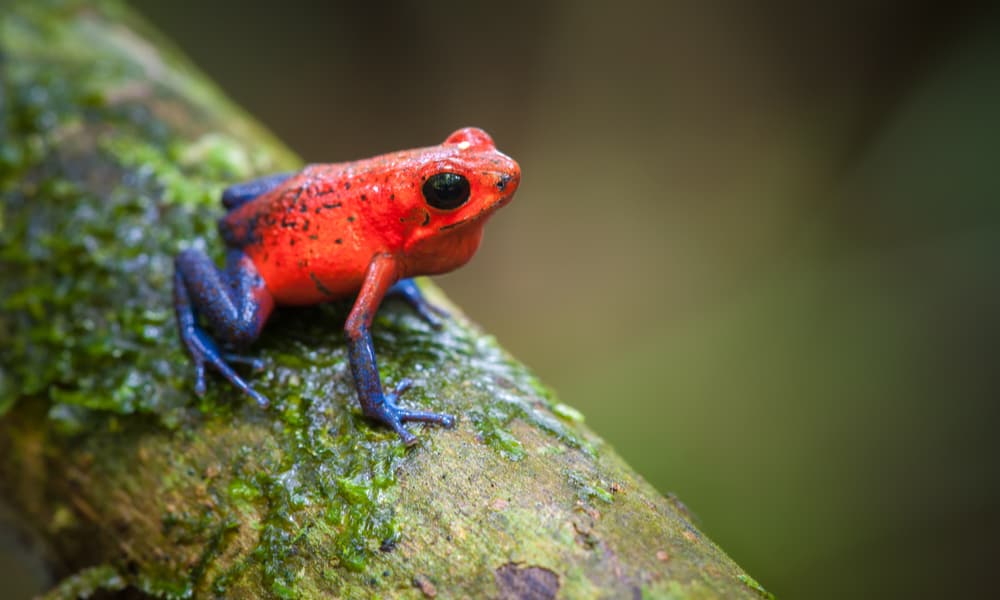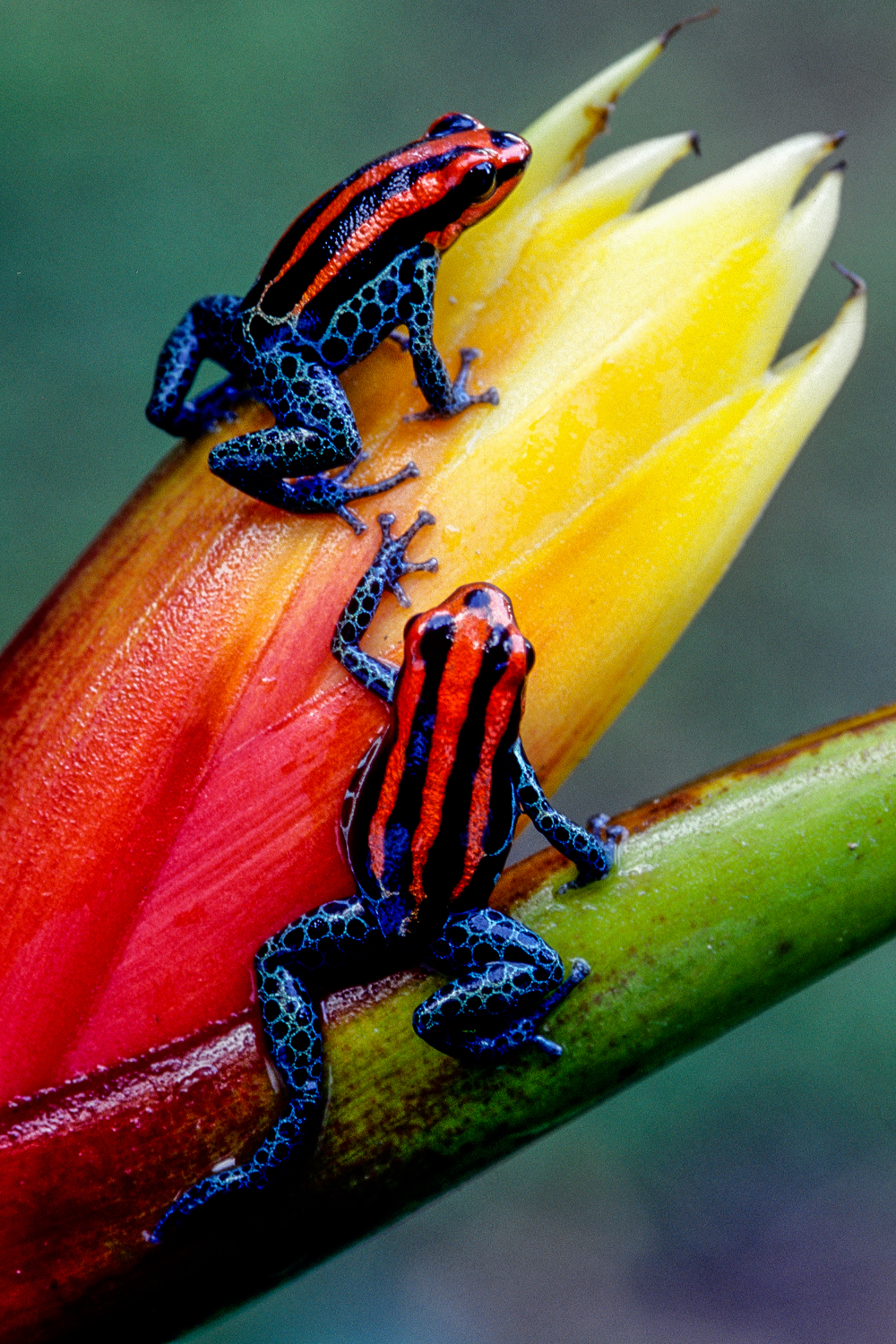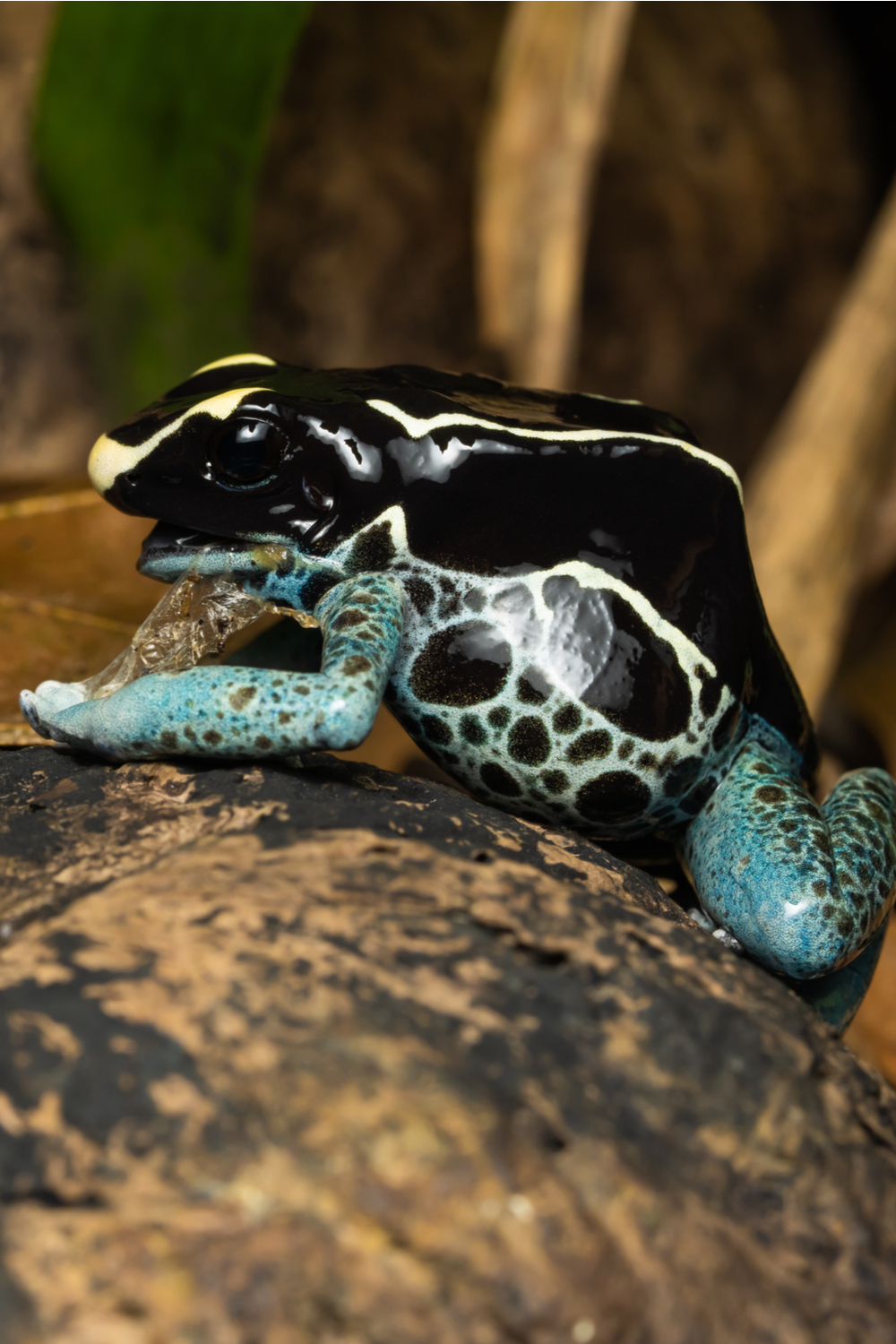“What does a poison dart frog eat” is a common question among exotic frog lovers. This is one of the more intriguing and beautiful species you can find in rainforests. As one of the most toxic animals on the planet, the poison dart frog always attracted the attention of biologists.
Poison Dart Frog Habits and biology
Poison dart frogs have various colors such as red, green, orange, yellow, blue. Like with many poisonous species, these colors signify that the animal is highly toxic. One frog has enough poison to kill 20,000 mice, which is why even larger predators are scared of it.
According to experts, the secret behind this toxin lies in the frog’s diet. They eat various insects, termites, crickets, and beetles, thus increasing their toxicity levels as they grow up. You can find them in the rainforests of Central and South America. Due to its unique skin, the frog is the main attraction in various zoos worldwide.
These frogs spend a lot of time in the water. As such, a humid tropical climate is ideal for them. Although they are mostly on the floor level, they can climb the trees. Unfortunately, while this is their ideal habitat, more and more frogs are spotted outside the rainforests due to deforestation.
Here are some of the habits that are common for this species:
- Poison dart frogs are diurnal. In other words, they do everything during the day. This makes the species quite unique, as most frogs are nocturnal animals.
- The main reason why frogs are diurnal is that their colors are visible during the day. Because of that, they are less likely to be eaten by predators. When the sun falls, they will find a suitable cover.
- This is a very sociable species. It isn’t uncommon to see groups of poison dart frogs. Although they stick together, males are quite territorial. The same can be said for females who tend to fight between each other for optimal egg-laying spots.
- Poison dart frogs caress each other with their chins and front legs during courting.
- There is a major variance in how many eggs a female can lay. They will have between 1 to 30 eggs after mating.
- Both parents take care of the eggs. Among others, it is very important to keep the eggs moist. Once the eggs hatch, the frogs will carry tadpoles to the nearest puddle or other water sources.
What do poison dart frogs eat in the wild?
Poison frogs are carnivorous species that hunt during the day. They are extremely opportunistic, using their sticky, long tongues to grab faster prey. They mostly focus on smaller insects with a soft exoskeleton. But they can also eat harder species such as beetles. Out of all the insects, they prefer crickets and fruit flies.
As mentioned, the reason why these frogs became poisonous is because of the food that they’re eating. Over thousands of years, the poison dart frogs have fed on various toxic species, which led to the development of unique traits. Interestingly enough, if they start eating non-toxic insects, they slowly lose their toxic potential.
When talking about tadpoles, they are mostly omnivorous. They will eat everything they can find while swimming in the water. This includes detritus, algae, dead insects, insect larvae, and so on.
Here are the main things that poison dart frogs eat in the wild:
- Ants
- Termites
- Fruit Flies
- Small Beetles
- Young crickets
Poison dart frogs always go with insects that are small enough for their mouth. For example, larger crickets can become a problem as they grow up quickly.
Besides protein, the animal needs a lot of vitamins and calcium. They can get a lot of protein from almost any type of insect. Calcium is important for various internal processes, and the same goes for vitamins. They also rely on various other nutrients, especially during reproduction.
As they can only eat smaller insects, an average frog will have to consume a lot of them to feel satiated. If we’re talking about juvenile frogs, they can eat up to 30 fruit flies each day. That is if they can catch them. As they grow a bit, their needs increase significantly.
A young adult frog can consume up to 75 flies every day. The good thing is that they don’t have to eat every day so, if they manage to hunt enough insects in a day or two, they won’t have to eat for several following days. A frog can survive several weeks without any food if they have a full belly.
21 Facts about poison dart frogs
There are so many interesting things about these beautiful animals. Here are some fun facts regarding poison dart frogs:
- Nowadays, the poison dart frog is regarded as an endangered species. In countries such as Ecuador (which can only be found in 7 places in a 2,100-mile area), their numbers are really low, but this trend is visible in other regions as well. This is mostly a result of severe deforestation.
- Besides deforestation, diseases and pet markets are other reasons why the species’ numbers are dwindling.
- When held captive, the frog loses its toxic traits. This is because zoos are forced to give them non-toxic insects that are otherwise uncommon in their natural habitat.
- A pain-killer drug called Epibatidine is made by using substances extracted from poison dart frogs. According to clinical data, the product is 200 times more potent than morphine.
- Like many other species, these animals can live much longer in zoos. There were cases of poison dart frogs reaching 15 years of age.
- Tadpoles will become adult frogs in 6 to 12 weeks.
- Their poison is deadly even for humans. Some types of poison dart frogs can produce such a strong toxin than 1/100,000 of an ounce would be enough to kill a person. Luckily, only 3 species are poisonous to humans.
- For hundreds of years, native tribes have used these frogs to coat their weapons. Then, these weapons would be used during wartime or for hunting larger game. First, tribesmen would pierce a frog and put it over a fire, thus forcing toxins to come out of their skin. Then, they would take a jar or similar vessel to collect the droplets.
- Just one frog can provide enough toxin to coat 50 arrows. If you decide to dry and store these arrows, you can use them for another 10 years without them losing potency.
- Toxic traits are characteristic of many amphibious species. These frogs, in particular, excrete poisonous substances from the glands on their back.
- As mentioned, the eggs have to be kept in a humid location. Females find an appropriate spot to lay them and then, the males take care of the rest by guarding them until they grow into tadpoles.
- When they become tadpoles, the frogs will climb onto their father’s back. Then, the male will carry them to a nearby water source and, when he finds it, he will shake off the tadpoles off the back, so they fall directly in.
- Experts categorize the golden poison frog as the most poisonous species on the planet.
- The frog’s toes are crucial for movement. They are wide and flat, which allows provides them a firm grip. Unlike many other frog species, they don’t have webbed feet that are great for swimming. The shape of their feet makes them more suitable for movement on the ground and in the trees than in the water.
- Although most poison dart frogs live in Central and South America, you can also find them in Hawaii.
- The color doesn’t only show that a frog is toxic; it also shows the level of toxicity. Brighter animals are more poisonous.
- Although the species has excellent senses, its eyesight is the most prominent feature.
- The frog can be as small as a thumbnail, and they don’t grow more than 2 inches in length.
- There are more than 170 different species of toxic frogs. We categorize them into 8 groups, and they are all parts of the Dendrobatidae family.
- It isn’t uncommon for female frogs to feed their tadpoles unfertilized eggs.
- These frogs have vocal cords that stretch alongside their vocal sacs. They inflate, and frogs utilize them as amplifiers. When a frog croaks, which is a common call, the animal will inhale air and then close its nostrils. By doing so, the air will be pressed forward and backward between the frog’s lungs and vocal sacs. The air will start vibrating due to interaction with vocal cords, thus causing the signature croaking sound.
Summary
Poison dart frogs are among the most toxic being on the planet. Their toxicity comes from the food they eat, and once a frog changes its diet, it will slowly lose this characteristic.
The frog is mostly active during the day because this is when its color is visible to predators. Both parents take care of the young ones. While poison dart frogs are highly sociable, they can also be very territorial.


